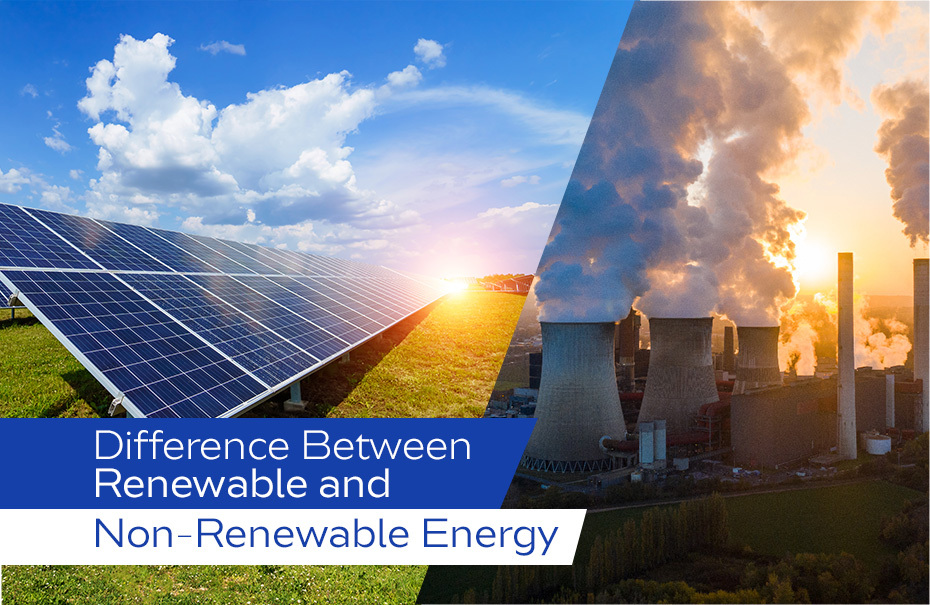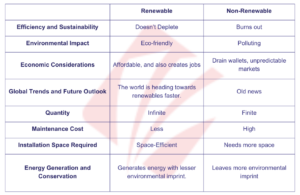Difference Between Renewable and Non-Renewable Energy

Talking about climate change and global warming makes the difference between renewable and non-renewable energy rather important. What then is the situation with these two kinds of energy sources?
Sources of renewable energy include wind and sunshine, which can restock themselves over time. On the flip side, non-renewable energy originates from sources like coal and oil that, once used up, cannot be replenished.
Now, why does it matter? Knowing this difference enables us to choose more wisely how we use energy and preserve our world for future generations.
We are becoming inventive as we seek more sustainable methods to power our planet. We’re using the wind, the light, and even the heat of the Earth. Perhaps you’ve heard of solar energy. It can heat our water, power our houses, and charge our phones. Still, there are other resources available, some of which are renewable and others of which are not.
But, before we go ahead to understand the difference between renewable and non-renewable energy, let’s first understand what these energy sources are.
What is Renewable Energy?
Renewable energy is power that comes from sustainable, never-ending supplies of natural resources. Many people believe that renewable energy sources are better for the environment than traditional energy sources since they do not release harmful pollutants or greenhouse gasses.
Renewable energy comes in many forms, and each one has its own set of advantages. Here are a few sources of renewable energy:
- Sun
- Wind
- Tidal
- Waves
- Geothermal
- Hydropower
- Soil
What is Non-Renewable Energy?
Renewable energy sources are continuously replenishable, whereas non-renewable energy sources rely on limited resources that will inevitably run dry. They are not favorable for the environment and less sustainable since they use non-renewable energy sources, which create pollution like greenhouse gasses.
Just like renewable energy sources, there are various types of non-renewable energy sources:
- Coal
- Oil
- Natural Gas
- Uranium
- Petroleum
Major Difference Between Renewable and Non-Renewable Energy Sources
Apart from the fact that non-renewable energy depletes over, and renewable doesn’t, what do you know the difference between renewable and non-renewable energy sources?
Efficiency and Sustainability
Renewable energy sources never run out of steam and never disappoint. Renewable energy sources are a more environmentally friendly way to power our homes and workplaces than fossil fuels like coal and oil, which deplete natural resources over time. As long as the Earth is in existence, it’s like having an endless supply of energy.
Environmental Impact
Solar and wind power, for example, provide electricity without releasing any toxins or emissions, in contrast to fossil fuels. Without contributing to global warming or other harmful atmospheric pollutants, solar panels and wind turbines respectively collect energy from the sun’s rays and the wind. So, throughout their useful lives, renewable energy systems leave much less of an ecological impact than conventional power plants.
Economic Considerations
Society and the environment both benefit from investments in renewable energy sources. Long-term cost reductions are another benefit of renewables, which also promise to provide employment and energy independence. By contrast, the high starting costs, price volatility, and reliance on highly volatile international markets of non-renewable energy production sometimes carry a significant risk.
Global Trends and Future Outlook
PM Narendra Modi invites the world to invest in India’s energy sector in his inaugural address at India Energy Week 2024. Thus, this is clear that renewable energy is gaining popularity rapidly throughout the globe. Renewables are gaining traction as a result of rising public awareness of climate change, governmental incentives, and technical developments.
But fossil fuels and other non-renewable energy sources are struggling with problems including outmoded infrastructure and powerful special interests. The transition from a flip phone to a smartphone is similar; change is occurring, but it’s not always simple to persuade your granny to make the leap.
Quantity
In terms of quantity, renewable energy supplies are endless, scattered, and abundant. You can derive energy from a wide variety of renewable sources, including the sun, wind, hydro, and geothermal heat. We worry about our energy security and the availability of resources in the future since non-renewable energy supplies are decreasing and limited. It’s the difference between a boundless buffet and a finite snack supply; the former gives you access to an infinite variety of foods, while the latter runs out before you want it to.
Maintenance Cost
Renewable energy solutions are reliable and low-maintenance- never let you down. They are more resistant to storms and need less care. However, the ongoing maintenance, safety investment, and environmental compliance requirements of non-renewable energy installations drive up their total cost.
Areas Required for Installing Power Systems
Renewable energy sources are surprisingly adaptable and space-efficient, though they do need some room to grow. Renewable energy sources can be situated in isolated places or incorporated into current infrastructure. They can take the form of rooftop solar panels or open-field wind turbines. On the other hand, sites that collect energy from non-renewable sources can result in significant damage to land, such as cutting down trees, destroying habitats, and upsetting ecosystems. The difference between renewables and non-renewables is like attempting to force a square peg into a round hole: renewables can adapt to their environment, whereas non-renewables produce more waste.
Energy Generation and Conservation
Energy from renewable sources, such as the sun and the wind, does not contribute to pollution or harmful emissions, in contrast to fossil fuels. Wind turbines and solar panels both generate electricity from the wind without adding to global warming or other harmful air pollution. Consequently, throughout their operational lives, renewable energy systems leave a much less environmental impact than non-renewable sources.

Similarities between Renewable and Non-Renewable Energy
Although there is a difference between renewable and non-renewable energy sources, there are similarities.
Both of them need Modern Tech Powers
Renewable sources like sun or wind power need the use of technological advancements due to which we are able to take advantage of their powers and convert them into electricity. Similarly, oil and gas also depend highly on modern technologies like fracking and horizontal drilling to increase the efficiency of extracting natural gas and oil.
Both Affect the Environment in Different Degrees
In comparison to nonrenewable sources, renewable energy sources like solar, wind, hydropower, and biomass tend to have less of an effect on the environment. One example is hydroelectric power, which uses the movement of water to produce energy. However, dams on a big scale have the potential to influence river flow, impact aquatic habitats, and disturb ecosystems.
Nuclear power, coal, oil, and natural gas are examples of non-renewable energy sources that are more harmful to the environment. The production of greenhouse gases like carbon dioxide and methane during the extraction, processing, and burning of fossil fuels is a major factor in the increase of global warming and the change in the climate.
Conclusion
We have learned the difference between renewable and nonrenewable energy sources, and now Vishakha Renewables can help you take use of solar power’s enormous potential. Solar aluminum frames,EVA encapsulants, backsheets, and glass are some of the most important raw materials of solar panels, and we are the leading manufacturer of solar materials in India of all these components. The process of converting the sun’s plentiful energy into sustainable electricity relies heavily on these parts.
The importance of switching to renewable energy sources is becoming more apparent, and Vishakha Renewables is emerging as a partner in this search. Use the sun’s plentiful energy to power your homes, organizations, and industries. This will not only reduce your carbon footprint but also contribute to a cleaner and more sustainable future.
FAQs
Can you give examples of 5 sources of renewable energy?
Hydroelectric, including tidal power, bioenergy (organic matter used as fuel), wind power, and solar power are all examples of renewable energy sources.
What are the three main differences between renewable and non-renewable energy?
Here are the three main differences:
- Availability and renewal times
- Environmental impact
- Installation costs
Is solar energy renewable?
As long as there is sunshine, there will be energy from the sun, making solar power a renewable and endless source of energy that does not contribute to global warming.
How can we save non-renewable resources?
Here are a few ways:
- Turning off air conditioners, lights, and fans when they are not in use.
- Preventing resource wastage is of the highest priority.
- You can carpool or take a means of public transport to save gas.
What is the process for creating renewable and nonrenewable resources?
Animal and plant fossils are the source of non-renewable energy. Forming nonrenewable energy sources requires a considerable amount of time. For this reason, it will not be renewed in the far future. You can find renewable energy sources in nature, and you can access them at any time, practically anywhere in the globe. In theory, there is a daily method to acquire and restock renewable resources. Any time there’s a breeze, we can turn the wind, sun, and water into energy.
Read More
